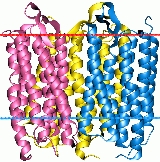
Bacterial rhodopsins
Encyclopedia
Bacterial rhodopsins are a family
of bacterial opsin
s. They are retinal-binding proteins
that provide light-dependent ion transport and sensory functions to a family of halophilic
and other bacteria. They are integral membrane proteins with seven transmembrane helices, the last of which contains the attachment point for retinal
(a conserved lysine).
The proteins from halobacteria
include bacteriorhodopsin
and archaerhodopsin, which are light-driven proton pump
s; halorhodopsin
, a light-driven chloride pump; and sensory rhodopsin, which mediates both photoattractant
(in the red) and photophobic (in the ultra-violet) responses. Proteins from other bacteria include proteorhodopsin
.
Protein family
A protein family is a group of evolutionarily-related proteins, and is often nearly synonymous with gene family. The term protein family should not be confused with family as it is used in taxonomy....
of bacterial opsin
Opsin
Opsins are a group of light-sensitive 35–55 kDa membrane-bound G protein-coupled receptors of the retinylidene protein family found in photoreceptor cells of the retina. Five classical groups of opsins are involved in vision, mediating the conversion of a photon of light into an electrochemical...
s. They are retinal-binding proteins
Retinylidene protein
Retinylidene proteins are a family of proteins that use retinal as chromophore for light reception. Proteins of this family are also called opsins...
that provide light-dependent ion transport and sensory functions to a family of halophilic
Halobacteria
In taxonomy, the Halobacteria are a class of the Euryarchaeota, found in water saturated or nearly saturated with salt. They are also called halophiles, though this name is also used for other organisms which live in somewhat less concentrated salt water...
and other bacteria. They are integral membrane proteins with seven transmembrane helices, the last of which contains the attachment point for retinal
Retinal
Retinal, also called retinaldehyde or vitamin A aldehyde, is one of the many forms of vitamin A . Retinal is a polyene chromophore, and bound to proteins called opsins, is the chemical basis of animal vision...
(a conserved lysine).
The proteins from halobacteria
Halobacteria
In taxonomy, the Halobacteria are a class of the Euryarchaeota, found in water saturated or nearly saturated with salt. They are also called halophiles, though this name is also used for other organisms which live in somewhat less concentrated salt water...
include bacteriorhodopsin
Bacteriorhodopsin
Bacteriorhodopsin is a protein used by Archaea, the most notable one being Halobacteria. It acts as a proton pump; that is, it captures light energy and uses it to move protons across the membrane out of the cell...
and archaerhodopsin, which are light-driven proton pump
Proton pump
A proton pump is an integral membrane protein that is capable of moving protons across a cell membrane, mitochondrion, or other organelle. Mechanisms are based on conformational changes of the protein structure or on the Q cycle.-Function:...
s; halorhodopsin
Halorhodopsin
Halorhodopsin is a light-driven ion pump, specific for chloride ions, and found in phylogenetically ancient archaea, known as halobacteria...
, a light-driven chloride pump; and sensory rhodopsin, which mediates both photoattractant
Phototropism
Phototropism is directional growth in which the direction of growth is determined by the direction of the light source. In other words, it is the growth and response to a light stimulus. Phototropism is most often observed in plants, but can also occur in other organisms such as fungi...
(in the red) and photophobic (in the ultra-violet) responses. Proteins from other bacteria include proteorhodopsin
Proteorhodopsin
Proteorhodopsin is a photoactive retinylidene protein in marine bacterioplanktons and eukaryotes. Just like the homologous pigment bacteriorhodopsin found in some archaea, it consists of a transmembrane protein bound to a retinal molecule and functions as a light-driven proton pump. Some members...
.

